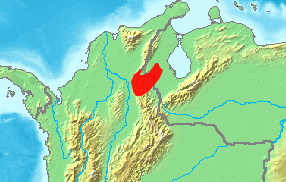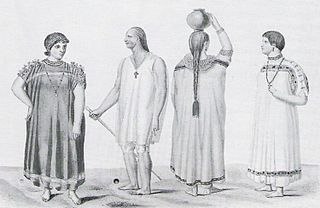
The Indigenous languages of the Americas are the languages that were used by the Indigenous peoples of the Americas before the arrival of non-Indigenous peoples. Over a thousand of these languages are still used today, while many more are now extinct. The Indigenous languages of the Americas are not all related to each other; instead, they are classified into a hundred or so language families and isolates, as well as a number of extinct languages that are unclassified due to the lack of information on them.

The Cariban languages are a family of languages indigenous to north-eastern South America. They are widespread across northernmost South America, from the mouth of the Amazon River to the Colombian Andes, and they are also spoken in small pockets of central Brazil. The languages of the Cariban family are relatively closely related. There are about three dozen, but most are spoken only by a few hundred people. Macushi is the only language among them with numerous speakers, estimated at 30,000. The Cariban family is well known among linguists partly because one language in the family—Hixkaryana—has a default word order of object–verb–subject. Prior to their discovery of this, linguists believed that this order did not exist in any spoken natural language.

The Yaruro people are a Circum-Caribbean indigenous people, native to the ecoregion of Llanos in Venezuela, located west of the Orinoco River. The Pumé people are divided into two subgroups: The River Pumé, living along major river drainages of the Orinoco River, and the more nomadic Savanna Pumé that reside on the Llanos.

The Constitution of Mexico does not declare an official language; however, Spanish is the de facto national language spoken by over 99% of the population making it the largest Spanish speaking country in the world. Due to the cultural influence of the United States, American English is widely understood, especially in border states and tourist regions, with a hybridization of Spanglish spoken. The government also recognizes 63 indigenous languages spoken in their communities out of respect, including Nahuatl, Mayan, Mixtec, etc.

Indigenous peoples of Mexico, Native Mexicans or Mexican Native Americans, are those who are part of communities that trace their roots back to populations and communities that existed in what is now Mexico before the arrival of Europeans.

In South America, Indigenous peoples comprise the Pre-Columbian peoples and their descendants, as contrasted with people of European ancestry and those of African descent. In Spanish, indigenous peoples are referred to as pueblos indígenas, or pueblos nativos. The term aborigen is used in Argentina, and pueblos aborígenes is commonly used in Colombia. The English term Amerindian is often used in the Guianas. Latin Americans of mixed European and Indigenous descent are usually referred to as mestizos (Spanish) and mestiços (Portuguese), while those of mixed African and Indigenous ancestry are referred to as zambos.

Filippo Salvatore Gilii (1721–1789), also known as Felipe Salvador Gilij, was an Italian Jesuit priest and a pioneering figure in the field of South American linguistics. Gilii’s work in the province of Venezuela, particularly along the Orinoco River, laid the foundation for much of what is known about the indigenous languages and cultures of the region. His contributions to linguistics, ethnography, and the understanding of indigenous South American societies have left an indelible mark on the academic world.

The Piaroa people, known among themselves as the Huottüja or De'aruhua, are a South American indigenous ethnic group of the middle Orinoco Basin in present-day Colombia and Venezuela, living in an area larger than Belgium, roughly circumscribed by the Suapure, Parguaza (north), the Ventuari (south-east), the Manapiare (north-east) and the right bank of the Orinoco (west). Their present-day population is about 15,000 (INE 2002), with an estimated 2,500 living on the left bank of the Orinoco River, in Colombia, in several reservations between the Vichada (north) and the Guaviare (south).
The Piaroa–Saliban, also known as Saliban, are a small proposed language family of the middle Orinoco Basin, which forms an independent island within an area of Venezuela and Colombia dominated by peoples of Carib and Arawakan affiliation.
Mochoʼ is a Mayan language spoken by the Mochoʼ people of Chiapas, Mexico. A source stated that it was known as Qatokʼ, although this name has not received wide acceptance among the native speakers and the language, which is known as Mochoʼ by both the Mochoʼ people and the Mexican government. Mochoʼ has a dialect called Tuzantec (Muchuʼ) spoken in Tuzantan, Chiapas. Alongside Jakaltek, Qʼanjobʼal, Chuj and Tojol-Abʼal, the Mochoʼ language is part of the Qʼanjobalan group from the western branch of Mayan languages.
Sapé, also called Kaliana or Caliana, is an extinct language recently spoken along the Paragua River and Karuna River. There were only about a few dozen speakers in the mid-1900s, and by the 2000s, only a few elderly speakers were found. Sapé may be a language isolate.

The languages of Venezuela refers to the official languages and various dialects spoken in established communities within the country. In Venezuela, Castillian is the official language and is the mother tongue of the majority of Venezuelans. Although there is an established official language, there are countless languages of indigenous villages spoken throughout Venezuela, and various regions also have languages of their own.
Esmeralda–Yaruro or Takame–Jarúroan, is a proposed connection between two unclassified languages of Venezuela and Ecuador: Yaruro, 6000 speakers, and the extinct Esmeralda. They would be only distantly related, but Kaufman (1990) finds the connection convincing, and Campbell (2012) believes the connection is promising.

The Motilones-Barí, sometimes also called Barís, Motilones or Dobocubis, are an indigenous people who live in the Catatumbo River basin in Norte de Santander Department in Colombia in South America and who speak the Barí language. They are descendants of the Tairona culture concentrated in northeastern Colombia and western Venezuela.
The Hodï language, also known as Yuwana (Yoana), Waruwaru, or Chikano (Chicano), is a small unclassified language spoken by the Hodï people of Venezuela. Very little is known of it; its several hundred speakers are monolingual hunter-gatherers. The people call themselves Jojodö or Wįlǫ̈, and their language Jojodö tjįwęnę. The two communities with the most speakers are San José de Kayamá and Caño Iguana, with several hundred speakers total.

The demographics of Colombia consist of statistics regarding Colombians' health, economic status, religious affiliations, ethnicity, population density, and other aspects of the population. Colombia is the second-most populous country in South America after Brazil, and the third-most populous in Latin America, after Brazil and Mexico.

The Chiquitano or Chiquitos are an indigenous people of Bolivia, with a small number also living in Brazil. The Chiquitano primarily live in the Chiquitania tropical savanna of Santa Cruz Department, Bolivia, with a small number also living in Beni Department and in Mato Grosso, Brazil. In the 2012 census, self-identified Chiquitanos made up 1.45% of the total Bolivian population or 145,653 people, the largest number of any lowland ethnic group. A relatively small proportion of Bolivian Chiquitanos speak the Chiquitano language. Many reported to the census that they neither speak the language nor learned it as children. The Chiquitano ethnicity emerged among socially and linguistically diverse populations required to speak a common language by the Jesuit Missions of Chiquitos.
The Cabildo Mayor del Pueblo Muisca is an organisation of indigenous people, in particular the Muisca. It was established in September 2002 in Bosa, Bogotá, Colombia. The organisation, member of National Indigenous Organization of Colombia (ONIC), focuses on defending the rights of the descendants of the Muisca, and the development of cultural and historical heritage, territory and health and the linguistics of the indigenous language, Muysccubun.

The indigenous languages of South America are those whose origin dates back to the pre-Columbian era. The subcontinent has great linguistic diversity, but, as the number of speakers of indigenous languages is diminishing, it is estimated that it could become one of the least linguistically diverse regions of the planet.
Apacuana —also transliterated as Apacuane, Apakuama or Apakuana—was a 16th-century woman of the Quiriquires, a branch of the Carib people that inhabited the Valles del Tuy region, in present-day Venezuela, notable for her leading role in a failed indigenous uprising against Spanish colonization in 1577. Her story was presented nearly a century and a half later by writer José de Oviedo y Baños in his 1723 book The Conquest and Settlement of Venezuela, a foundational work on the country's history. Introduced by the author as an "elderly sorceress and herbalist", Apacuana is considered to have been a piache, that is, a curandera, a term used in Hispanic America to call a healer or shaman. She was the mother of Guásema, who served as cacique—a term used to designate indigenous tribal chiefs in Hispanic America—while several modern writers consider her to have been a cacica as well.













